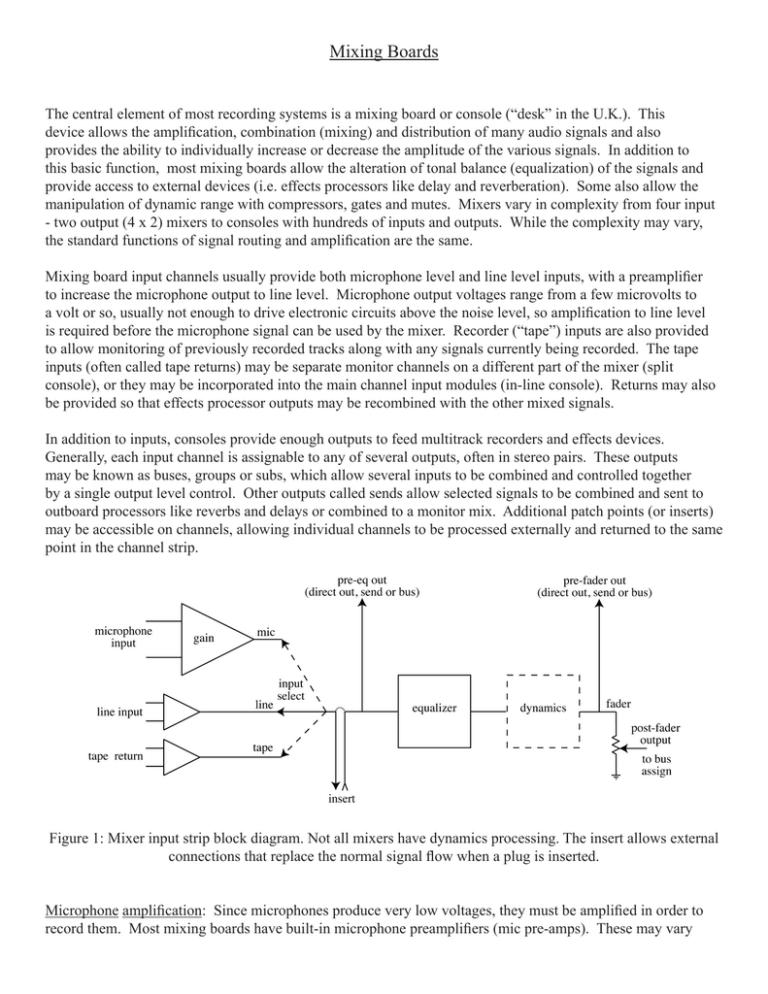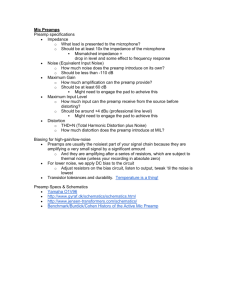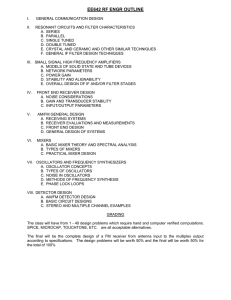Mixing Boards
advertisement

Mixing Boards The central element of most recording systems is a mixing board or console (“desk” in the U.K.). This device allows the amplification, combination (mixing) and distribution of many audio signals and also provides the ability to individually increase or decrease the amplitude of the various signals. In addition to this basic function, most mixing boards allow the alteration of tonal balance (equalization) of the signals and provide access to external devices (i.e. effects processors like delay and reverberation). Some also allow the manipulation of dynamic range with compressors, gates and mutes. Mixers vary in complexity from four input - two output (4 x 2) mixers to consoles with hundreds of inputs and outputs. While the complexity may vary, the standard functions of signal routing and amplification are the same. Mixing board input channels usually provide both microphone level and line level inputs, with a preamplifier to increase the microphone output to line level. Microphone output voltages range from a few microvolts to a volt or so, usually not enough to drive electronic circuits above the noise level, so amplification to line level is required before the microphone signal can be used by the mixer. Recorder (“tape”) inputs are also provided to allow monitoring of previously recorded tracks along with any signals currently being recorded. The tape inputs (often called tape returns) may be separate monitor channels on a different part of the mixer (split console), or they may be incorporated into the main channel input modules (in-line console). Returns may also be provided so that effects processor outputs may be recombined with the other mixed signals. In addition to inputs, consoles provide enough outputs to feed multitrack recorders and effects devices. Generally, each input channel is assignable to any of several outputs, often in stereo pairs. These outputs may be known as buses, groups or subs, which allow several inputs to be combined and controlled together by a single output level control. Other outputs called sends allow selected signals to be combined and sent to outboard processors like reverbs and delays or combined to a monitor mix. Additional patch points (or inserts) may be accessible on channels, allowing individual channels to be processed externally and returned to the same point in the channel strip. Figure 1: Mixer input strip block diagram. Not all mixers have dynamics processing. The insert allows external connections that replace the normal signal flow when a plug is inserted. Microphone amplification: Since microphones produce very low voltages, they must be amplified in order to record them. Most mixing boards have built-in microphone preamplifiers (mic pre-amps). These may vary in quality from atrocious to excellent. The mic preamps may account for much of the cost of mixing boards, since each input channel can cost hundreds of dollars. Fortunately, recent advances in integrated circuit design and manufacture have allowed the production of higher quality preamplifiers in the 10’s of dollars range, contributing to the availability of acceptable quality affordable mixers. Since microphones often need 60 dB of amplification, their amplifiers’ performance is critical. Mic preamps must be able to handle large dynamic range signals without distortion, which means they need to have high voltage and wide bandwidth capability without introducing noise even at very high gains. Many engineers favor using external preamps for their most critical recordings. These devices can cost as much as a low-end console for two channels of microphone amplification. There is undeniably an advantage to using these highly-optimized preamps when working with consoles with average quality built-in preamps. Compromises must be made to fit the required number of preamps into the space and cost of any console, compromises which are not necessary in an outboard preamp. There are considerations in addition to the obvious need for noise-free undistorted gain in a microphone preamp: the input impedance of the preamp can audibly affect the microphone output, especially if it is transformer-coupled. The ability to provide clean phantom power to a wide range of capacitor microphones is also a consideration. Since the output impedance and phantom power requirements of microphones varies, a preamp must be flexible to fill a range of such needs. Microphone preamplifiers are often described by whether they use solid state devices or vacuum tubes as gain elements and the circuit topology employed. These factors can make a difference in the sound of the preamp, although it is not a simple as assuming tubes always sound “warmer” than solid-state units. The performance of a preamp is affected by the interaction with its input device as well as its internal performance. A well-designed vacuum-tube preamp may well sound as clean and focused as a solid-state device. Preamps using transformers often produce a characteristic sound due to the imperfections in the transformer, like low-frequency distortion and high amplitude saturation. This may produce the “warm” sound we are after when recording to digital recorders, but transformers can be designed to be quite transparent as well. Tubes also tend to produce evenorder harmonic distortion which is sometimes desired, particularly when judged against voltage limited clipping that can occur in transistor circuits running on low power supply voltages. In addition to the type of gain element, the circuit topology may contribute to the overall sound a preamp produces. Amplifiers are described by a classification: class A, AB, B, and others. These classifications consider the way power is used by the amplifier. A class A amplifier always draws current from the power supply even with no signal present. While this results in high power consumption and heat production, it creates little distortion since the amplification devices are always on. In order to avoid the large power consumption, class B amplifiers may be constructed which use a pair of complementary output devices (either transistors or tubes), each of which conducts on half of the cycle. The problem is then that the zero-crossings may contribute distortion if not very carefully adjusted. There are variations of these types like class AB, and more exotic types with switched power applied during large voltage swings. Another amplifier design consideration is the use of negative feedback, where the output is inverted and fed back to the input. This has the effect of minimizing distortion in the amplifier and stabilizing it so that it does not tend to oscillate. Again, this must be done carefully as it also may degrade the amplifier’s ability to follow rapid changes in input voltages. Since op-amps are designed to employ negative feedback, their performance may be inherently limited relative to circuits using discrete devices and less feedback, particularly at high gain. Summing amplifiers: In analog mixers, another type of amplifier is used to combine, or mix, signals. This amplifier must be able to add many signals together without allowing any interaction between the outputs of the circuits producing the signals. This can easily be achieved with operational amplifiers in the inverting configuration. Unfortunately, this configuration inverts the signal. Usually, there are several stages of amplification involved in a mixer and hopefully the signal which emerges is a non-inverted replica of the input. This may not be the case, as some stages of amplification may not be applied to all signals. As a general rule, the more complex a mixer, the greater the likelihood of phase inversion on at least some of the signals. Any shortcomings in a mixing (summing) amplifier will be reflected in the final stereo mix: since all signals must pass through the summing amplifier, the design of this stage is also of critical importance. The simple op-amp summing amplifier works for a small number of inputs but begins to have problems if too many inputs are connected. The more inputs to the summing amplifier, the higher gain it must deliver. So for mixing a few signals, the summing amp runs a low gain while the gain increases as more signals are added to the mix. Since op-amps may have audibly different sound characteristics based on the amount of gain they must deliver, this is undesirable. The inverting summing amplifier is also sensitive to ground loop-induced noise, since it references its output to the non-inverting input, which is connected to circuit ground. Given the size of modern large consoles, ground loops are as significant a problem as they are for the studio at large. While other combining circuits are possible, they are much more expensive to implement, as some of these involve a differential internal bus structure and some require heavy cables for summing buses that run the width of the console. This explains some of the cost of high-end consoles. Signal Routing: In addition to amplitude manipulations, mixers are used to control the flow of signals from one point to another. This can be done by means of switches which send the signal to different outputs or mixing amplifiers (“buses”), or by potentiometers which can “pan” (from panorama) the signal from left to right in a stereo mix. Often, input channels of a mixer have “insert” points or patch points which allow each input signal to be separately routed to an external device and then brought back to the same place in the mixer so it can be mixed with other signals. Direct outputs send the signal to external devices but do not provide a signal return to the mixer. Direct outputs are most often used to send individual signals to a recorder. Often, a mute switch is available to temporarily turn off selected signals without altering gain or other settings. A solo circuit functions as a separate mixing bus which allows the engineer to monitor selected signals in the control room while those in the studio continue to hear the complete mix. This can be of great help in isolating noise or other problems in a complex mix. The solo signal can be taken before the channel fader (PFL=pre-fader listen) or after the channel fader (AFL). In the first case, the fader position will not affect the solo signal. This arrangement also applies to direct outs and sends. Many consoles make pre-/post- fader selection switchable or alterable with internal jumpers. For signal monitoring, it may be useful to monitor pre-fader. For effects, though, it is usually desirable to monitor post-fader so the effect send level tracks the fader level and the effect isn’t fed signal when the direct (dry) signal fader is off. Mixer outputs include a main stereo output used to record the stereo mix, individual group or bus outputs that may also be combined to feed the main stereo output, monitor outputs to feed headphones for performers and effects send outputs. Group/bus outputs are sometimes called sub-groups as these can be used to group sub-mixes (e.g. drums, vocals, etc.) so a single fader can control a combination of signals together. There are often multiple monitor sends available so that each performer can have a distinct monitor mix independent of the main stereo mix. Some mixers have inserts on the group and/or stereo outputs so that outboard effects processing can be applied to those signals. Stereo outputs for studio and control room monitoring are generally available with selectable sources. Faders: One of the main functions of a mixer is to allow each channel’s level in the mix to be manipulated, so a principal control is the fader. A fader is a linear (as opposed to rotary) potentiometer which controls each channel’s level sent to the summing bus. The physical construction of the fader determines how it feels when it’s moved and how the level increases and decreases as the fader is moved up and down. There are different materials used in the resistive element: carbon composition and conductive plastic are the most common. The exact taper of the resistance as the wiper moves along the resistive surface determines how the signal level changes as the fader is moved and several resistance curves are available, from linear to logarithmic to audio taper. Since all faders on a console must have matching behavior, their construction accuracy is important. The best faders can cost hundreds of dollars each. Some mixers are capable of automated control, which in analog mixers requires a motor connected to the fader to allow electronic control of fader movement. This further increases the cost. Alternatively, a voltage controlled amplifier (VCA) can be used to provide electronically variable level control rather than requiring motorized faders. Digital mixers do not require motorized faders - in fact the signal does not go thought a fader at all Equalization: Another function found on mixing consoles is equalization (EQ). The equalizer is a special form of amplifier that provides gain that is frequency-dependent: the engineer can set the relative gain differently for different frequency bands. The tone control found on stereos is a simple form of equalizer. Generally, each input module provides some EQ control, sometimes allowing hard-wired bypass if the equalization is not needed. Many types of equalizer are available and the type employed varies from manufacturer to manufacturer. The “sound” of the equalizer is determined by the type and quality of the actual design employed, so functionally similar EQs on different consoles can sound different. Some engineers have distinct preferences, but it is usually possible to create a similar sound with any of the available consoles. Filter Types Filter Parameters “Q” boost/cut Frequency shelving (low) peaking graphic shelving (high) Gain Gain 0 Gain F Frequency Frequency Figure 2: Filter parameters and types. Specific types of equalizers commonly found on mixers include parametric, semi-parametric, and shelving types. Parametric filters allow the user to adjust the center frequency, width of the frequency band, and amount of boost/cut for each filter band. Semi-parametric EQ lacks the bandwidth adjustment of the fully parametric type. Shelving filters boost or cut all frequencies above or below the corner frequency and are commonly used as tone controls on stereos as well as on consoles. Graphic equalizers, which provide a separate boost/ cut adjustment for from 5 to 30 fixed frequency bands, are rarely used on consoles but are often found on PAtype mixers and outboard equalizers. Each type of equalizer has distinct uses, from adjusting small ranges of problematic frequencies to sculpting the entire low or high end of the musical signals. Choosing the proper type of equalizer will simplify the job of altering the program tonal balance. The type of electronic circuitry used in a filter can make an audible difference. Although modern designs lean heavily on capacitor/op-amp filter stages, designs using inductors are returning to popularity despite their greater cost. These circuits have a distinctive sound reminiscent of the early days of recording, possibly due to the saturation effect inductors generate when the iron cores can no longer accept the magnetic flux demanded by high-level signals. Whatever the cause, the sound of these older designs, like the Pultec equalizers, is very music-friendly. Inductors are sometimes simulated using capacitors and op-amps in a circuit known as a gyrator. These equalizers are able to create filters that behave similarly to inductor-based equalizers without some of the drawbacks of using inductors. Digital mixers use digital filters to produce equalization and the algorithms used produce various types of filters, ranging from simple functions to complex simulations of analog circuits, creating many options for different applications. Dynamics processing: Once available only on the most expensive large-format consoles, dynamic range processing is now a standard feature of most digital mixing boards. The ability to alter the dynamic range of a signal is very helpful in constructing a complex mix of sounds so that we may still clearly perceive the individual elements. Dynamic range processors are amplifiers with variable gain, which may be controlled by a control signal derived from the sound signal itself. It allows the variations of loudness of a sound to be reduced by an arbitrary amount. Think of an engineer with a hand on the fader, turning it down when it gets loud. Using the envelope of the signal as a measure of its loudness, we can use the signal amplitude to control the fader level automatically, creating a compressor. Output Level (V) Compressor gain parameters knee linear gain linear gain non-linear gain slope 2:1 5:1 20:1 threshold level 0 Input Level (V) Figure 3: Compressor input/output characteristics. The threshold is the input amplitude above which gain is reduced. The slope is the system gain. The ratio (input:output) sets the gain above threshold. A compressor allows several parameters to be set that control how the gain is affected. The threshold setting determines the input amplitude above which gain is reduced, the ratio determines how much it is reduced when the input exceeds the threshold, the attack time determines how long it takes to reduce the gain and the release determines how long it takes for the gain to return to normal after the input level drops below threshold. Makeup gain is a linear gain after the compressor which amplifies the compressed signal so that the now-reduced peaks are as loud as they were before. This also increases the level of the softer sounds which were not being compressed. The net effect is a reduction in the dynamic range. A limiter is a compressor with a very high ratio. Generally it also uses a higher threshold to absolutely limit the output level but not alter the balance of quiet to loud sounds as much as a compressor does. Another dynamics processor is the expander, which reduces the signal gain when the level drops below a threshold. This has the effect of reducing or eliminating background noise. A gate turns off the signal completely when it falls below the threshold amplitude while an expander reduces the gain below threshold, in effect turning down low-amplitude signals like noise or microphone leakage. This effectively increases the dynamic range. Expanders can also operate by increasing the gain above threshold, the opposite of what a compressor does. Signal Level Displays: Mixing boards always provide some type of signal level indicators, either mechanical VU-type meters or LED displays. VU (volume unit) indicators are specially calibrated meters that indicate the perceived loudness of the signal being monitored. LED displays usually display the peak level, and thus are better indicators of the amplitude of short transients, which may cause overload distortion in recorders and processors. Many boards have LED overload indicators on the preamps, allowing trim adjustment of incoming signals. LED ladder displays can show either peak or average/RMS levels, so the manual must be checked to know which happens on a specific device. Some digital level displays show both RMS and peak levels at the same time. The combination of metering types available allow the engineer to monitor each signal level in the board so signal-to-noise ratio and distortion performance can be optimized. Gain Structure: Although metering is intended to convey signal levels in the mixer, there are potential problems keeping the gains of each block in the signal flow at optimal levels. Generally, the VU meters are indicating the levels at the summing bus outputs and hopefully some indicators monitor the preamp levels. But with dynamics processors and equalizers on each channel, there are potentially some circuits without adequate signal level monitoring. The level at which clipping occurs may differ for each functional block in the mixer, so we must be careful not to apply too much gain with equalizers, for example, that then lead to overloads in subsequent stages. Don’t assume that because the preamp level isn’t clipping that the signal can’t overload at some subsequent stage. One important measure of mixer quality is the amount of headroom throughout the entire system. So how to avoid undesired overloads? The best way is to experiment a little and see how easily you can get a signal to overload. (Not during a session, of course.) By playing a signal back and moving the various gains up, you can determine when clipping occurs by ear. Try boosting the high and low equalizers until you get distortion. This will give you an idea how much headroom is available. (This is another reason why using cut may be preferable to using boost in an equalizer.) A few minutes of experimentation may save a lot of time later on in the project. Also, check any circuit diagrams provided by the manufacturer: some will include headroom information for the various functional blocks. Analog versus digital: Due to their low cost, digital mixers are rapidly replacing analog mixers. Digital mixers still need analog microphone preamps and line/tape inputs, but these are then sampled by analog-to-digital converters and the remaining functions of mixing and processing are done digitally. Outputs are available for connection to both analog and digital systems. Most digital mixers are patterned after analog mixers in signal flow and processing, so the same principles are at play whether one uses an analog or digital mixer. On digital mixers, functions like equalization and compression are handled by DSP programs, eliminating the costs associated with duplicating analog circuitry otherwise required. This has led to mixers with greatly expanded processing and routing capabilities at lower prices, so even entry-level mixers can be used for complicated mixes. Beginning engineers are often faced with high-complexity mixers that can be confusing unless the basic concepts of mixer operation are well understood. © 2014 Jay Kadis (For educational use only) monitor mix effects sends (stereo) mute solo equalizers tape returns mic preamps bus assign effects returns faders master fader




